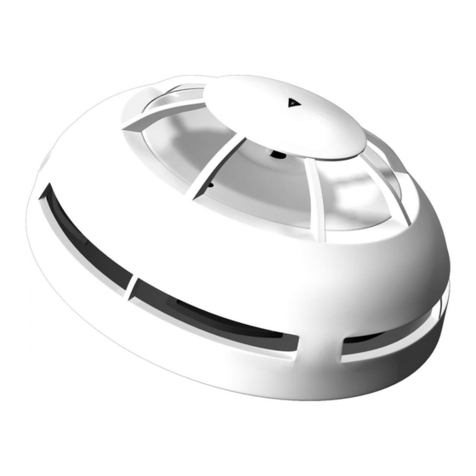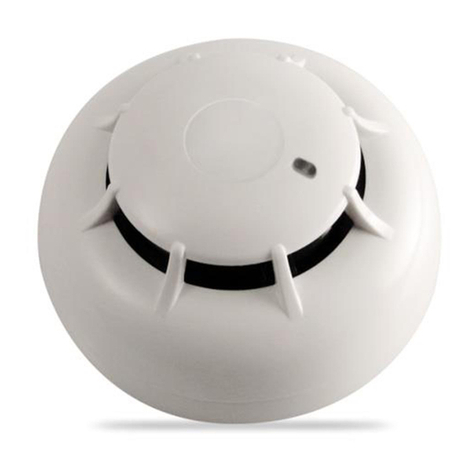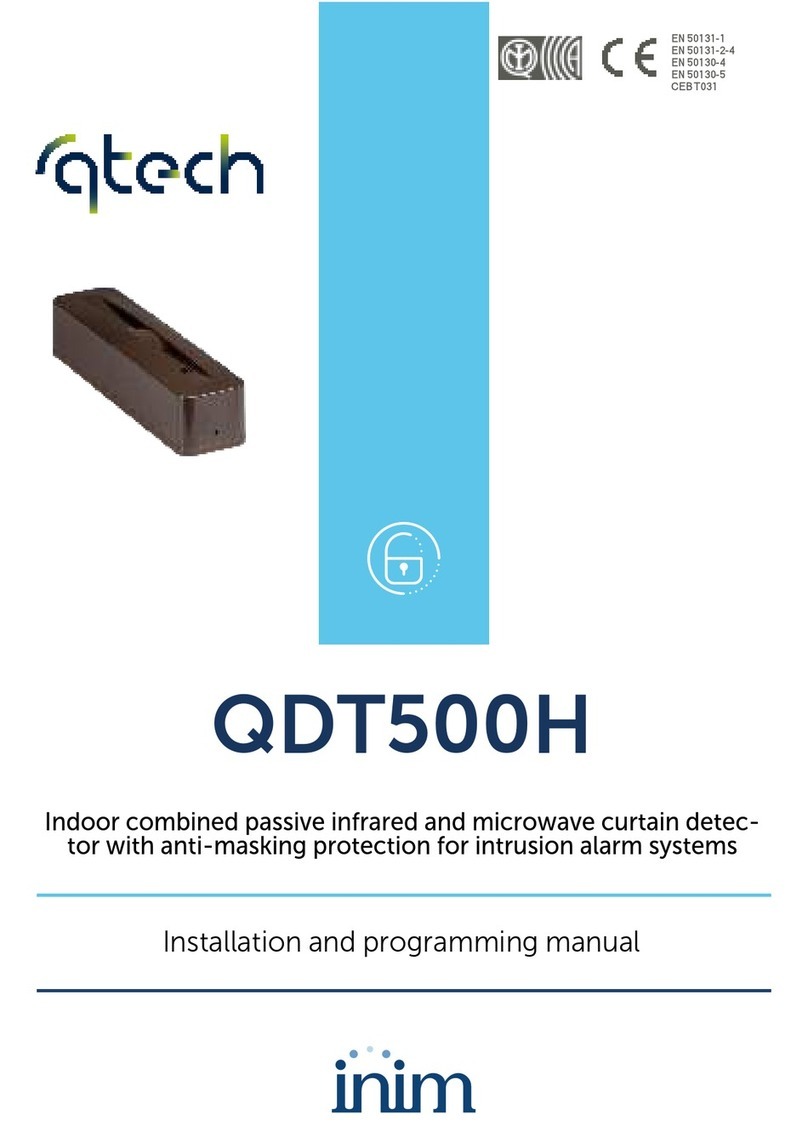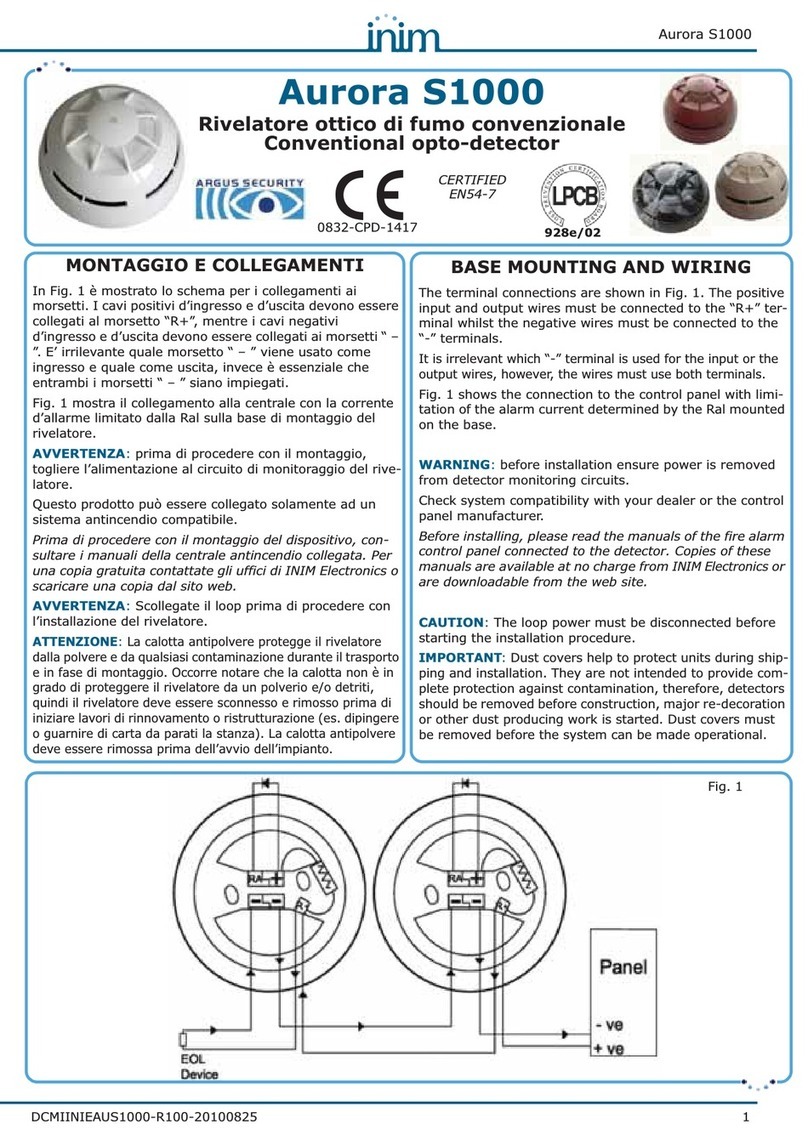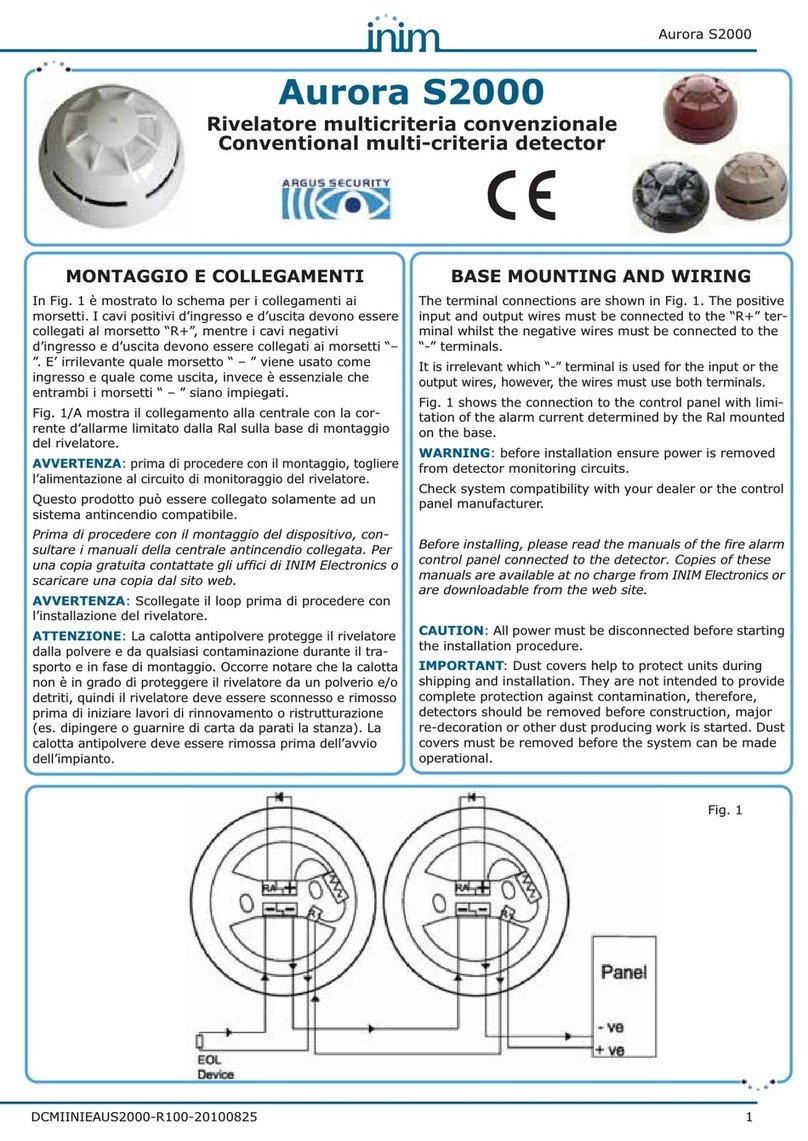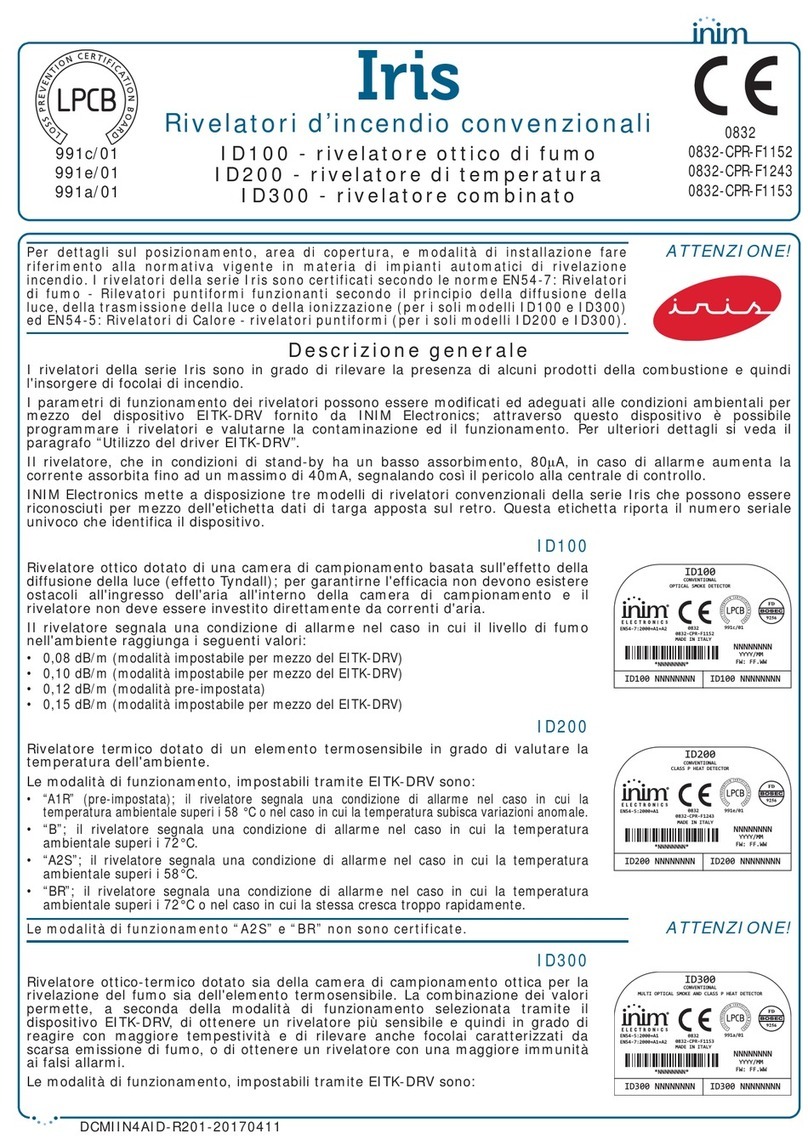POWERING UP - FIRST TIME USE - WITHOUT INSULATING TAB
Use this procedure the first time you power up a WD200; the detector has not been supplied with the insulating tab.
1) Make sure the Link / program switch is set on “ON”.
2) Insert the two supplied batteries into their device’s lodgments.
POWERING UP - DEVICE LINKED TO THE SYSTEM
Use this procedure when a WD200 is successfully linked to its Fire Vibes system and you have to extract one or both batteries (e.g. batteries
substitution).
1) Reinsert the battery or both batteries into their lodgments.
If performing a batteries substitution, use two brand new batteries and substitute both of them.
Do not touch the Link / program switch.
POWERING UP - RECOVERY
Use this procedure when you fail to link successfully a WD200 or you want to link it again.
1) Move alternatively the Link / program switch 5 times.
2) Set the Link / program switch on “ON”.
3) Insert the two supplied batteries into their device’s lodgments.
LINKING - WAKE-UP - WITHOUT INSULATING TAB
“Wake-up” linking consists in associating one or more child devices to the Fire Vibes system altogether in a single operation.
Wake-up is performed either through the Fire Vibes Studio software or the EWT100 / IWT100 keyboard-screen interface; it CANNOT be
done through XWT100 devices.
1) Create the “virtual model” of the WD200 either on Fire Vibes Studio or on the EWT100 / IWT100.
2) Power-up the detector (either “first time use” or “recovery”).
3) Set the Link / program switch OPPOSITE to “ON”.
4) Trigger the wake-up procedure either from Fire Vibes Studio or from the EWT100 / IWT100.
5) Wait the end of the “wake-up” linking procedure.
6) Check on Fire Vibes Studio or from EWT100 / IWT100 for linking success. Consult their user manual.
LINKING - ONE-BY-ONE - WITHOUT INSULATING TAB
“One-by-one” linking consists in associating one child device at a time to the Fire Vibes system.
This operation is performed either through the Fire Vibes Studio software or the EWT100 / IWT100 keyboard-screen interface; it CANNOT be
done through XWT100 devices.
1) Create the “virtual model” of the child device either on Fire Vibes Studio or on the EWT100 / IWT100.
2) Trigger the linking procedure either from Fire Vibes Studio or from the EWT100 / IWT100.
3) Power-up the child device (either “first time use” or “recovery”).
4) Set the child device’s Link / program switch OPPOSITE to “ON”.
5) Wait the end of the “one-by-one” linking procedure.
6) Check on Fire Vibes Studio or from EWT100 / IWT100 for linking success. Consult their user manual.
TESTING
Magnet test
1) Activate test mode.
2) Apply again the magnet in correspondence of the “magnet test activation area”.
3) LED indicators signal “Alarm activation”.
Heat test
1) Activate test mode.
2) Apply the heat test device to the detector.
3) Wait a few seconds.
4) LED indicators signal “Alarm activation”.
BATTERY FAULTS AND BATTERY SUBSTITUTION PROCEDURE
When one or both batteries are low in charge, a specific fault message is routed to the
control panel. If such event occurs:
1) Remove the safety screw.
2) Remove the detector from its base.
3) Remove the batteries cover.
4) Extract both batteries.
5) Insert both new batteries into their holders, oriented as per polarity marks.
See POWERING UP - DEVICE LINKED TO THE SYSTEM.
6) Reinstall the batteries cover.
7) Reinstall the detector.
8) Reinstall the safety screw.
Local safety standards may require you
to test these devices on a regular basis.
Use only suitable heat test devices supplied by
approved manufacturers. Follow their specific
use instructions.
Before testing every WD200, always
activate test mode. This is done by
holding a suitable magnet in the
“magnet test activation area”. When activated,
LED indicators signal “Test mode active”.
When a low battery condition is indicat-
ed, both batteries must be changed
altogether.
Batteries must be brand new.
Do not touch the Link / program switch.
Ensure that the batteries are installed properly,
with their polarities matching the indications on
the device.
Always ensure that the batteries are
installed properly, with their polarities
matching the indications on the device.
INIM ELECTRONICS S.R.L. VIA DEI LAVORATORI 10, FRAZIONE CENTOBUCHI, 63076 MONTEPRANDONE, ITALY www.inim.biz
3
MAINTENANCE - CLEANING
1) Remove the safety screw.
2) Remove the detector from its base.
3) Thermistor area: use a small, soft bristle brush to dislodge any obvious contaminants such as insects, spider webs, hairs, etc.
4) Thermistor area: use a small vacuum tube or dry, clean, compressed air to suck up or blow any remaining small particles away.
5) Wipe the exterior housing of the detector with a clean, damp, lint-free cloth to remove any surface film that can later attract airborne
contaminants.
6) Install the detector onto its base again.
7) Test the detector.
8) Reinstall the safety screw.
TECHNICAL SPECIFICATIONS *
*See TDS-TWDTX technical specification document for further technical data.
** Detector’s rate of rise (A1R) / high temperature (BS) modes can be set through Fire Vibes Studio .
BATTERIES SPECIFICATIONS
*Batteries lifespan depends by environmental conditions, default monitor settings and link quality.
Specification Value
Communication range with EWT100, IWT100 or XWT100 network
devices 200 m (in open space)
Wireless frequency band(s) of operation 868-868.6 MHz, 868.7-869.2 MHz, 869.4-869.65 MHz, 869.7-870.0 MHz
Number of wireless channels 66
RF output power (max) 14 dBm (25 mW) e.r.p.
Temperature alarm threshold (A1R rate of rise setting) ** 58 °C
Temperature alarm threshold (BS high temperature setting) ** 78 °C
Operating temperature range -10 °C to 55 °C
Maximum humidity (non condensing) 95% RH
IP rating 40
Specification Value
Batteries type CR123A (3 V, 1.25 Ah)
Batteries lifespan * 10 years
Low battery threshold value (nominal) 2.850 V
Table 2
Table 3
WARNINGS AND LIMITATIONS
Our devices use high quality electronic components and plastic materials that are highly resistant to
environmental deterioration. However, after 10 years of continuous operation, it is advisable to replace
the devices in order to minimize the risk of reduced performance caused by external factors. Ensure
that this device is only used with compatible control panels. Detection systems must be checked,
serviced and maintained on a regular basis to confirm correct operation. Smoke detectors may respond
differently to various kinds of smoke particles, thus application advice should be sought for special risks.
Detectors cannot respond correctly if barriers exist between them and the fire location and may be
affected by special environmental conditions. Refer to and follow national codes of practice and other
internationally recognized fire engineering standards. Appropriate risk assessment should be carried
out initially to determine correct design criteria and updated periodically.
Use only in Fire Vibes fire detection and alarm systems.
WARRANTY
All devices are supplied with the benefit of a limited 5 years warranty relating to faulty materials or
manufacturing defects, effective from the production date indicated on each product. This warranty is
invalidated by mechanical or electrical damage caused in the field by incorrect handling or usage.
Product must be returned via your authorized supplier for repair or replacement together with full infor-
mation on any problem identified. Full details on our warranty and product’s returns policy can be
obtained upon request.
4
INIM ELECTRONICS S.R.L.
VIA DEI LAVORATORI 10
FRAZIONE CENTOBUCHI
63076 MONTEPRANDONE (AP)
ITALY
EN 54-5:2017+ A1:2018
EN 54-25:2008
WD200
WD200B
Wireless Heat Detector for fire detection
and fire alarm systems installed in
buildings
Level or class of the performance per
each essential characteristic can be
found in the Declaration of Performance
0051
22
0051-CPR-2764
